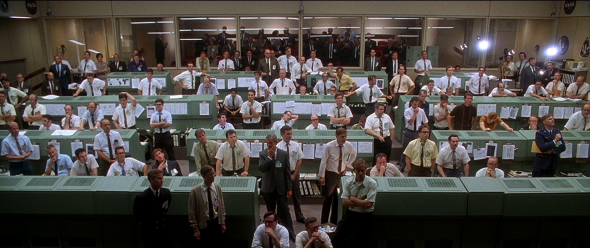The title of Hidden Figures, the hit historical drama nominated for Best Picture on Tuesday, has two meanings. It refers to the way that the behind-the-scenes mathematics of spaceflight rarely get their due; after all, the stories we read and see about the American space program typically focus on the astronauts in all their flashy, buzz-cut glory. They’re a lot more glamorous than the number crunchers who calculated orbital trajectories at the Langley Research Center in Virginia.
It’s impossible to watch Hidden Figures and not think of two previous Best Picture–nominated movies that told stories of the space race: 1983’s The Right Stuff and 1995’s Apollo 13. But Hidden Figures’ title also refers, of course, to the fact that its three heroines—like the many other black “computers” who worked for NASA in the space race, and like black employees at many institutions—were doubly hidden, discriminated against in their own time and often overlooked now. And so I found myself thinking harder about those two previous award-winning space movies. The Right Stuff focused squarely on John Glenn (Ed Harris), Gus Grissom (Fred Ward), and the other test pilots–turned–star voyagers who charismatically touched the sky. Apollo 13 let its astronauts share the story with the control-room types, epitomized by flight director Gene Kranz (Ed Harris, again). Both movies are filled with scenes of white men in ties staring up at control screens. What figures were hidden? Should any of Hidden Figures’ heroines have appeared in those movies?

Universal
Take Apollo 13, which tells the story of an ill-fated 1970 mission to the moon. The Wikipedia page of Katherine Johnson, the heroine played in Hidden Figures by Taraji P. Henson, notes that her calculations “helped safely return the crew to Earth.” Should a Katherine Johnson have been in the Apollo 13 control room, furiously solving equations on the fly, as Tom Hanks and Kevin Bacon wrestled with the controls up in space?
It turns out that Johnson’s calculations did come into play in the Apollo 13 rescue, but they were calculations she’d made years before. As Margot Lee Shetterly writes in the book that served as the basis for Hidden Figures, Johnson and her colleague Al Hamer co-authored a series of papers starting in 1967 that gave astronauts a method of navigation by the stars should onboard computers fail. As it happened, a cloud of debris surrounding Apollo 13 prevented the astronauts on board from navigating by the stars, but a related technique—using the Earth’s terminator, the line that separates day from night on the planet’s surface—allowed the astronauts to execute a final fuel burn that corrected their re-entry path and kept them from skipping off into space forever. (Both Johnson’s navigate-by-stars method and the terminator method get a brief mention in the film.)
Well, what about The Right Stuff, which tells, in part, the same story as that told in Hidden Figures—the story of John Glenn’s 1962 flight to orbit the Earth? Viewed after watching Hidden Figures, The Right Stuff is even more conspicuous in its whiteness, but it’s hard to say that it’s dishonest. The film—like Tom Wolfe’s book—doesn’t mention Katherine Johnson or portray John Glenn’s actual request, pre-launch, that NASA “get the girl to check the numbers” for his re-entry coordinates. But that’s of a piece with the film’s general lack of interest in the math that got Glenn into the air and brought him down in one piece.
And what about The Right Stuff’s dramatization of Glenn’s dangerous re-entry—when the heat shield seems to have come loose and the control room doesn’t know if Glenn will burn up? After all, in Hidden Figures, she’s right there in the tension-filled control room with flight director Al Harrison (Kevin Costner) and all those white guys in ties. She even speaks up to confirm, at a crucial moment, that a plan to secure the heat shield by not jettisoning another part of the craft will work.
But in this respect, both The Right Stuff and Hidden Figures necessarily simplify the teams of geniuses and reams of research and calculation necessary to make spaceflight happen. In an interview with Space.com, Shetterly lamented that those watching the film might get the impression “that these were the only people doing those jobs, when in reality we know they worked in teams, and those teams had other teams. There were sections, branches, divisions, and they all went up to a director. There were so many people required to make this happen.” According to Gene Kranz’s memoir Failure Is Not an Option, the decision not to jettison the retro pack—in order to secure the heat shield to the craft—was researched, evaluated, and fiercely debated inside and outside the control room through Glenn’s third and final orbit, before mission director Walter Williams made the final call. Costner’s character? A fictional invention of the film.
And where was Johnson? As Shetterly’s book makes clear, Johnson performed her calculations at her desk in Building 1244 on Langley’s West Side, far from the control room in Florida. Dramatic license, you might say, to put her at the center of the action in Hidden Figures’ exciting climax. Maybe you’ll shake your head at Hollywood treacle, or see social-justice conspiracies in the movie’s vaunting of its heroine. Me, I prefer to think of that engaging, satisfying sequence as a long-overdue correction: a film finally putting at center stage the people who have remained “hidden” far too long.
